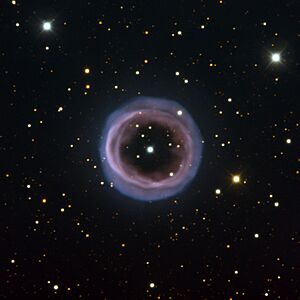Shapley 1 facts for kids
Shapley 1, also known as Sp 1 or PLN 329+2.1, is a beautiful object in space called a planetary nebula. It's found in a group of stars called the constellation of Norma. Even though it's called a "planetary" nebula, it has nothing to do with planets! It's actually a cloud of gas and dust that looks a bit like a planet through a telescope.
Contents
What is Shapley 1?
Shapley 1 is a special kind of cloud in space. It's made of gas and dust that a dying star has puffed out. This star, which is very hot, lights up the gas around it. This makes the nebula glow brightly. It looks like a ring or a bubble in the sky.
Why is it Called a Planetary Nebula?
The name "planetary nebula" can be a bit confusing. It was first used in the 1700s by an astronomer named William Herschel. When he looked through his telescope, these objects looked round and green, a bit like the planet Uranus. So, he called them "planetary" nebulae. But remember, they are not planets and they don't form planets! They are just glowing clouds around old stars.
How Far Away is Shapley 1?
Shapley 1 is very far from Earth. It is about 1,000 light-years away.
What is a Light-Year?
A light-year is a way to measure huge distances in space. It's the distance that light travels in one whole year. Light moves incredibly fast, about 300,000 kilometers (186,000 miles) every second! So, 1,000 light-years means that the light we see from Shapley 1 today actually left the nebula 1,000 years ago.
Who Discovered Shapley 1?
This amazing nebula was discovered by an American astronomer named Harlow Shapley. He found it in 1936. That's why it's named after him! Harlow Shapley was famous for his work on the size of our galaxy, the Milky Way.
Where Can You Find Shapley 1?
Shapley 1 is located in the southern sky. You can find it in the constellation called Norma.
What is the Norma Constellation?
Norma is a small constellation. It means "the carpenter's square" in Latin. It's not one of the most famous constellations, but it's home to interesting objects like Shapley 1. You would need a telescope to see Shapley 1 clearly.


